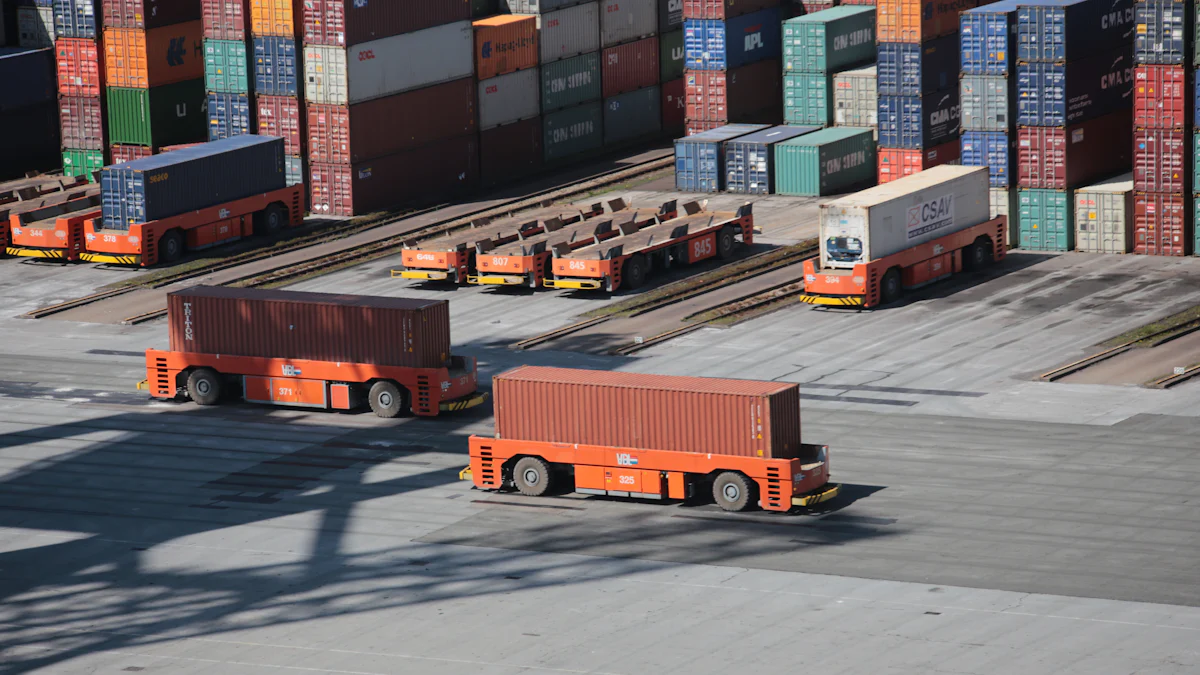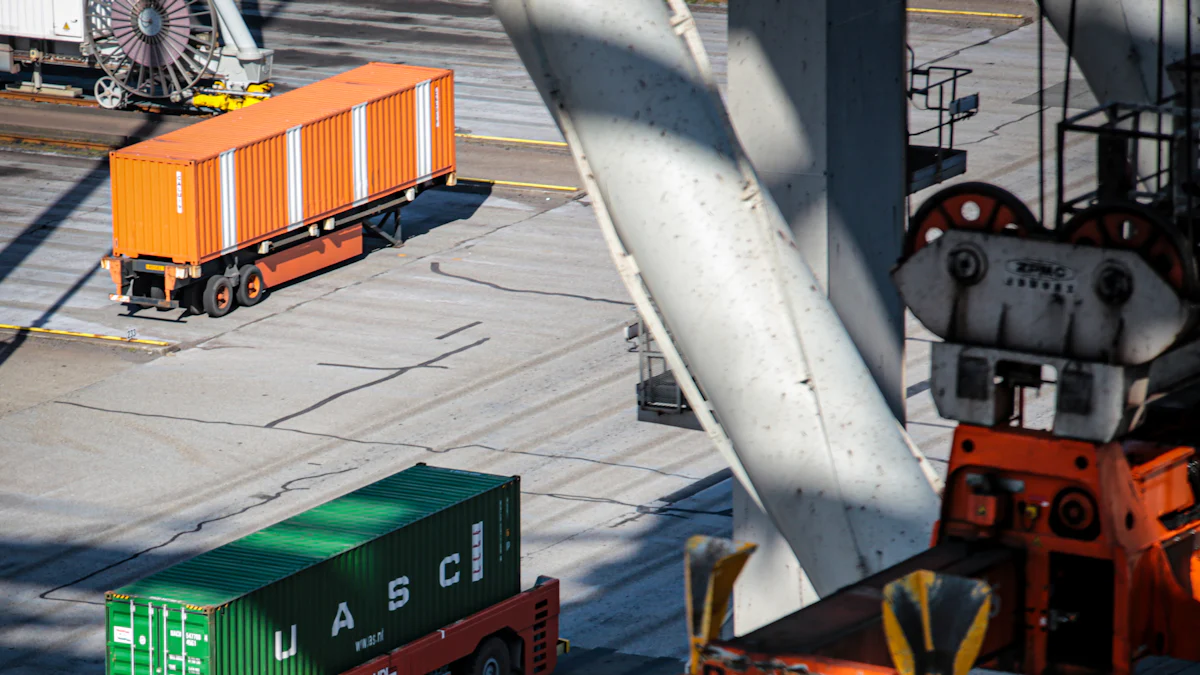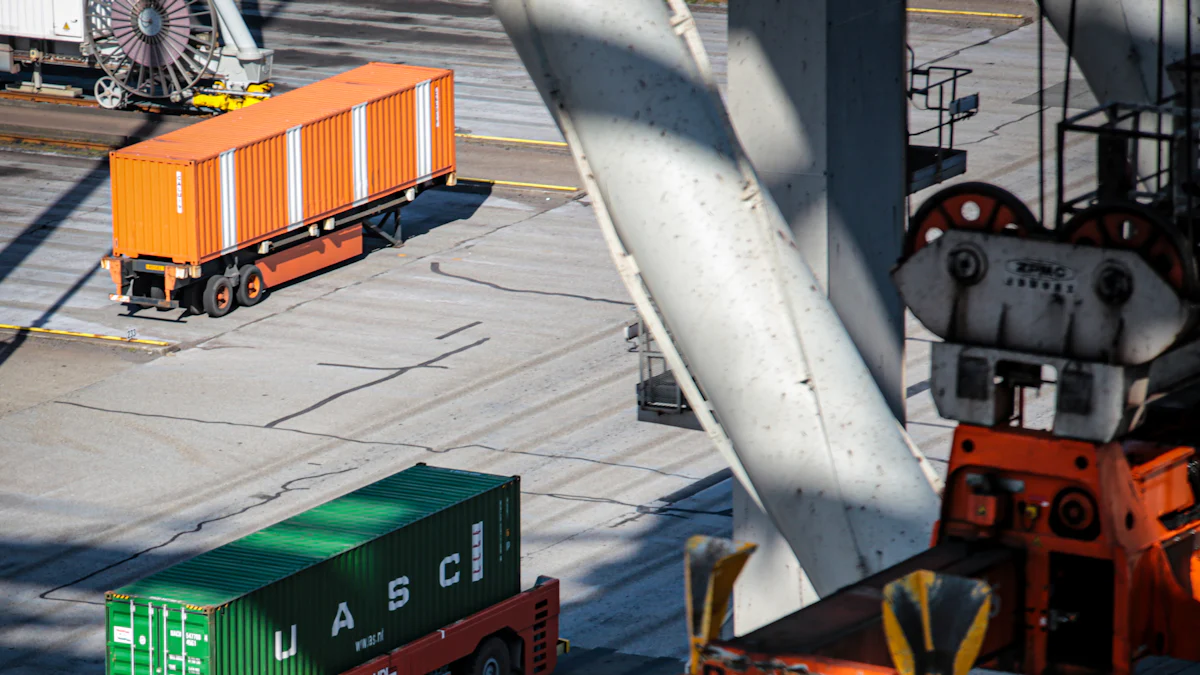Top AGV Technology Updates You Need to Know

Automated Guided Vehicles (AGVs) have revolutionized the logistics and material handling industries. AGV robots perform tasks with high efficiency and precision, enhancing productivity and safety in various environments. The global AGV market is projected to reach $5.5 billion by 2025, reflecting a compound annual growth rate of 7.5%. AGVs can operate continuously without breaks, handle repetitive tasks without fatigue, and improve worker safety by taking on hazardous duties. These advancements make AGVs indispensable in modern warehouses and production lines.
Key Trends Driving AGV Technology
Integration of AI
Benefits of AI in AGVs
Artificial Intelligence (AI) has transformed the capabilities of AGV robots. AI enables AGVs to perform complex tasks with greater efficiency. The integration of AI enhances decision-making processes, allowing AGVs to navigate dynamic environments seamlessly. AI-driven AGVs can autonomously detect and avoid obstacles, ensuring smoother operations in warehouses and factories. This leads to reduced downtime and increased productivity.
Examples of AI applications in AGVs
AI applications in AGV robots include obstacle detection and avoidance. For instance, a project developed an AI-driven AGV based on the TPV company’s chassis. This AGV autonomously handles unexpected obstacles using machine learning and avoidance algorithms. Another example involves AI-powered AGVs optimizing route planning and task scheduling. These applications demonstrate the significant impact of AI on AGV performance.
IoT Integration
How IoT enhances AGV capabilities
The Internet of Things (IoT) significantly enhances AGV capabilities. IoT enables AGV robots to communicate and share data in real-time. This connectivity improves coordination and efficiency in manufacturing and supply chain operations. IoT integration allows AGVs to monitor their environment continuously. This results in better decision-making and adaptive responses to changes in the operational landscape.
Case studies of IoT in AGVs
Several case studies highlight the benefits of IoT in AGVs. For example, logistics companies use IoT-enabled AGVs for efficient warehouse management. These AGVs can track inventory levels and optimize storage space. Another case study involves AGVs in manufacturing plants, where IoT integration facilitates seamless communication between AGVs and other automated systems. These examples showcase the transformative potential of IoT in enhancing AGV functionalities.
Machine Learning
Machine learning algorithms in AGV robots
Machine learning algorithms play a crucial role in the advancement of AGV robots. These algorithms enable AGVs to learn from data and improve their performance over time. Machine learning helps AGVs adapt to new tasks and environments. This adaptability is essential for handling diverse and dynamic operational requirements. Algorithms such as reinforcement learning and neural networks are commonly used in AGV systems.
Practical applications and benefits
Practical applications of machine learning in AGVs include predictive maintenance and path optimization. Machine learning algorithms analyze data from sensors to predict potential failures and schedule maintenance proactively. This reduces downtime and maintenance costs. Path optimization algorithms help AGVs find the most efficient routes, minimizing travel time and energy consumption. These benefits contribute to the overall efficiency and reliability of AGV robots.
Technological Advancements in AGVs

Advanced Sensing Technologies
Types of sensors used in AGVs
Advanced sensing technologies have significantly enhanced the capabilities of Automated Guided Vehicles (AGVs). Modern AGVs utilize various types of sensors to perform their tasks with precision. Laser sensors enable AGVs to navigate by detecting obstacles and mapping their surroundings. Ultrasonic sensors measure distance by using sound waves, providing accurate proximity data. Vision sensors capture images to help AGVs recognize objects and read barcodes. Infrared sensors detect heat signatures, allowing AGVs to identify the presence of humans or other heat-emitting objects. These sensors work together to ensure that AGVs operate safely and efficiently in dynamic environments.
Impact on AGV performance
The integration of advanced sensors has a profound impact on AGV performance. Laser-guided vehicles (LGVs) offer precise navigation, reducing errors and increasing operational efficiency. Ultrasonic sensors enhance obstacle detection, preventing collisions and ensuring smooth operations. Vision sensors improve the AGV's ability to handle complex tasks such as sorting and picking. Infrared sensors contribute to worker safety by detecting human presence and avoiding accidents. These advancements lead to higher productivity, reduced downtime, and improved accuracy in material handling and logistics operations.
Navigation Systems
Latest navigation technologies
Navigation systems in AGVs have evolved significantly, incorporating cutting-edge technologies. Early AGVs relied on wires and tape for guidance. Modern AGVs use laser-guided systems for precise navigation. These systems employ laser beams to create a virtual map of the environment, enabling AGVs to navigate autonomously. Simultaneous Localization and Mapping (SLAM) technology allows AGVs to build and update maps in real-time while tracking their location. Magnetic navigation involves following magnetic strips embedded in the floor, offering a reliable and cost-effective solution. Inertial navigation systems use accelerometers and gyroscopes to track the AGV's movement, ensuring accurate positioning even in challenging conditions.
Improvements in AGV navigation accuracy
Recent advancements have significantly improved AGV navigation accuracy. Laser-guided systems provide centimeter-level precision, reducing the risk of errors and enhancing task efficiency. SLAM technology enables AGVs to adapt to changes in the environment, maintaining high accuracy even in dynamic settings. Magnetic navigation ensures consistent performance, making it suitable for various industrial applications. Inertial navigation systems offer robust performance in environments where other navigation methods may fail. These improvements result in better route planning, reduced travel time, and increased overall efficiency in AGV operations.
Impact of Technological Advancements
Enhanced Capabilities of AGVs
Increased efficiency and productivity
Technological advancements have significantly increased the efficiency and productivity of AGV robots. AI-driven AGVs can autonomously detect and avoid obstacles, ensuring smoother operations in dynamic environments. For example, a project developed an AI-driven AGV that combines LiDAR and vision data for obstacle detection and avoidance. This integration reduces downtime and enhances overall productivity.
Machine learning algorithms enable AGV robots to optimize routes and schedules. These algorithms analyze data from sensors to predict potential failures and schedule maintenance proactively. This reduces downtime and maintenance costs. IoT integration allows AGVs to communicate and share data in real-time, improving coordination and efficiency in manufacturing and supply chain operations.
Expanded applications in various industries
AGV robots have expanded their applications across various industries due to technological advancements. In logistics, AGVs transport raw materials from receiving areas to warehouses or directly to production lines. Manufacturing plants use AGVs for efficient warehouse management, tracking inventory levels, and optimizing storage space.
AI and machine learning have enabled AGVs to handle a wider range of tasks. Improved navigation and control systems allow AGVs to adapt to new tasks and environments. This adaptability is essential for handling diverse and dynamic operational requirements. AGVs now perform complex tasks such as sorting, picking, and even assembly operations in production lines.
Case Studies
Real-world examples of AGV implementations
AI-Driven AGV for Obstacle Detection and Avoidance: A project developed an AI-driven AGV that combines LiDAR and vision data for obstacle detection and avoidance. This AGV autonomously handles unexpected obstacles using machine learning and avoidance algorithms. The integration of AI enhances decision-making processes, allowing AGVs to navigate dynamic environments seamlessly.
IoT-Enabled AGVs in Manufacturing Plants: Manufacturing plants use IoT-enabled AGVs for seamless communication between AGVs and other automated systems. These AGVs monitor their environment continuously, resulting in better decision-making and adaptive responses to changes in the operational landscape. IoT integration facilitates efficient warehouse management, tracking inventory levels, and optimizing storage space.
Success stories and lessons learned
Logistics Company Integrates AI-Powered AGVs: A logistics company integrated AI-powered AGVs to optimize route planning and task scheduling. These AGVs reduced downtime and increased productivity by autonomously detecting and avoiding obstacles. The success of this implementation highlights the significant impact of AI on AGV performance.
Manufacturing Plant Implements IoT-Enabled AGVs: A manufacturing plant implemented IoT-enabled AGVs for efficient warehouse management. These AGVs facilitated seamless communication with other automated systems, improving coordination and efficiency. The success of this implementation demonstrates the transformative potential of IoT in enhancing AGV functionalities.
Market Trends and Economic Impact
Current Market Trends
Growth statistics and projections
The Automated Guided Vehicle (AGV) market has shown remarkable growth. The global AGV market is expected to reach $5.5 billion by 2025. This growth reflects a compound annual growth rate of 7.5%. The increasing demand for automation in logistics and manufacturing drives this expansion. AGVs offer enhanced efficiency and safety, making them indispensable in modern industrial operations.
Key players in the AGV market
Several key players dominate the AGV market. Companies like KION Group, Toyota Industries Corporation, and JBT Corporation lead the industry. These companies invest heavily in research and development. They focus on integrating advanced technologies such as AI and IoT into their AGV systems. This commitment to innovation ensures that these companies remain at the forefront of the market.
Economic Impact
Cost savings and ROI
AGVs provide significant cost savings for businesses. These vehicles reduce labor costs by performing tasks that would otherwise require human workers. AGVs can operate continuously without breaks, increasing productivity. The initial investment in AGVs often results in a high return on investment (ROI). Businesses see reduced downtime and maintenance costs due to the reliability of AGV systems.
Broader economic implications
The broader economic implications of AGVs are substantial. AGVs improve worker safety by taking on hazardous duties. This reduction in workplace accidents leads to lower insurance premiums and healthcare costs. The efficiency of AGVs contributes to faster production cycles and shorter delivery times. This efficiency boosts overall economic productivity. The adoption of AGVs also drives technological advancements in related fields, fostering innovation and growth across industries.
Future of AGVs

Predictions for AGV Technology
Emerging trends and innovations
The future of Automated Guided Vehicles (AGVs) promises exciting advancements. Emerging trends indicate that AGV robots will increasingly integrate with Industry 4.0 technologies. This integration will enhance their capabilities and versatility. AI-driven AGV robots will perform more complex tasks with greater efficiency. Machine learning algorithms will enable AGVs to adapt to new environments and tasks seamlessly.
Innovations in sensor technology will further improve AGV performance. Advanced sensors will provide more accurate data, enhancing navigation and obstacle detection. IoT-enabled AGVs will communicate in real-time, improving coordination and efficiency in operations. These advancements will make AGV robots indispensable in various industries.
Potential challenges and solutions
Despite the promising future, AGV technology faces several challenges. One major challenge involves ensuring the security of data transmitted by IoT-enabled AGVs. Cybersecurity measures must be robust to protect sensitive information. Another challenge is the high initial investment required for AGV systems. Businesses must consider the long-term benefits and ROI to justify the cost.
To address these challenges, companies can invest in advanced cybersecurity solutions. Regular updates and monitoring will ensure data protection. For the cost issue, businesses can explore leasing options or phased implementation. This approach allows gradual integration of AGV robots, reducing the financial burden.
Importance of Staying Updated
Resources for keeping informed
Staying updated with the latest AGV technology is crucial for businesses and professionals. Several resources can help keep informed about advancements in AGV robots. Industry journals and magazines often publish articles on the latest trends and innovations. Websites of leading AGV manufacturers provide valuable insights into new products and technologies.
Attending industry conferences and trade shows offers opportunities to learn from experts. Networking with other professionals can also provide valuable information. Online courses and webinars can help deepen understanding of AGV technology. These resources ensure that businesses remain competitive by leveraging the latest advancements.
Call-to-action for readers
Businesses must prioritize staying informed about AGV technology. Regularly reading industry publications and attending events will provide valuable insights. Investing in training and development will enhance the skills of the workforce. Implementing the latest AGV technologies will improve efficiency and productivity.
Readers should take proactive steps to stay updated. Subscribe to industry journals and follow leading AGV manufacturers. Attend conferences and participate in webinars. By staying informed, businesses can harness the full potential of AGV robots and maintain a competitive edge.
AGV technology continues to evolve with significant advancements in AI, IoT, and machine learning. These innovations enhance AGV capabilities, making them indispensable in various industries. Staying updated with the latest developments ensures businesses can leverage these technologies for improved efficiency and productivity.
"AI technology is advancing rapidly with new use cases being presented for tomorrow's industry."
Businesses should prioritize continuous learning and adaptation. Subscribing to industry journals, attending conferences, and participating in webinars will provide valuable insights. By staying informed, companies can maintain a competitive edge and fully harness the potential of AGV technology.
See Also
Best Power Banks to Consider in 2024
The Importance of Influencer Marketing for Brands
Understanding Email Automation and Its Functionality